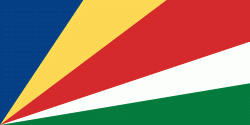Flag of Seychelles
The flag of Seychelles (Drapeau des Seychelles) was adopted on January 8, 1996. The current flag is the third used by the country since its independence from Britain on June 29, 1976. The colours used in the current flag are the official colours of two of the nation's major political parties: the Seychelles People's United Party and the Seychelles Democratic Party.
This unique flag consists of five different coloured bands (blue, yellow, red, white, and green) starting from one end and diverging towards the other end. The oblique bands symbolize a dynamic new country moving into the future. The colour blue depicts the sky and the sea that surrounds the Seychelles. Yellow is for the sun which gives light and life, red symbolizes the people and their determination to work for the future in unity and love, while the white band represents social justice and harmony. The green depicts the land and natural environment.
This unique flag consists of five different coloured bands (blue, yellow, red, white, and green) starting from one end and diverging towards the other end. The oblique bands symbolize a dynamic new country moving into the future. The colour blue depicts the sky and the sea that surrounds the Seychelles. Yellow is for the sun which gives light and life, red symbolizes the people and their determination to work for the future in unity and love, while the white band represents social justice and harmony. The green depicts the land and natural environment.
National flag
Country - Seychelles
Warning: getimagesize(/Image/Map/MP241170.gif): failed to open stream: No such file or directory in /home/mapnlee7/public_html/MAPNALL/article.php on line 532
 |
Seychelles was uninhabited prior to being encountered by Europeans in the 16th century. It faced competing French and British interests until coming under full British control in the late 18th century. Since proclaiming independence from the United Kingdom in 1976, it has developed from a largely agricultural society to a market-based diversified economy, characterized by rapidly rising service, public sector, and tourism activities. From 1976 to 2015, nominal GDP grew nearly 700%, and purchasing power parity nearly 1600%. Since the late 2010s, the government has taken steps to encourage foreign investment.
